Ask any audiophile who has been in the hobby for a decade or more to identify a legacy brand, and the name McIntosh will almost certainly be mentioned. Founded by Frank McIntosh and residing in Binghamton, New York since 1952, McIntosh recently celebrated their 75th anniversary. Almost from their inception, McIntosh has been known for two design cues still in use today. One is their patented Unity Coupled Transformer technology, which delivers a consistent wattage output across a two-ohm, four-ohm or eight-ohm load in tube-based amplifiers. The second is their trademarked, greenish-blue lights, which adorn every component they make. This includes the MT5 turntable highlighted in this review.
On the MT5 turntable, McIntosh is using a magnetic main bearing along with a ceramic shaft. This provides a magnetically suspended platter which is obsessively quiet . They also added the McIntosh name on the front, which, when playing an LP, lights up with the famed greenish blue light. Not stopping with the name, the acrylic platter is awash with the same familiar light show. Whatever may be said about McIntosh, it cannot be denied they have the coolness factor down cold. This turntable looks incredible when being played in low light. While we all, admittedly, are duly impressed with looks and coolness, our main concerns are features and how it sounds. As it turns out, the McIntosh MT5 Precision turntable does an impressive job there as well.
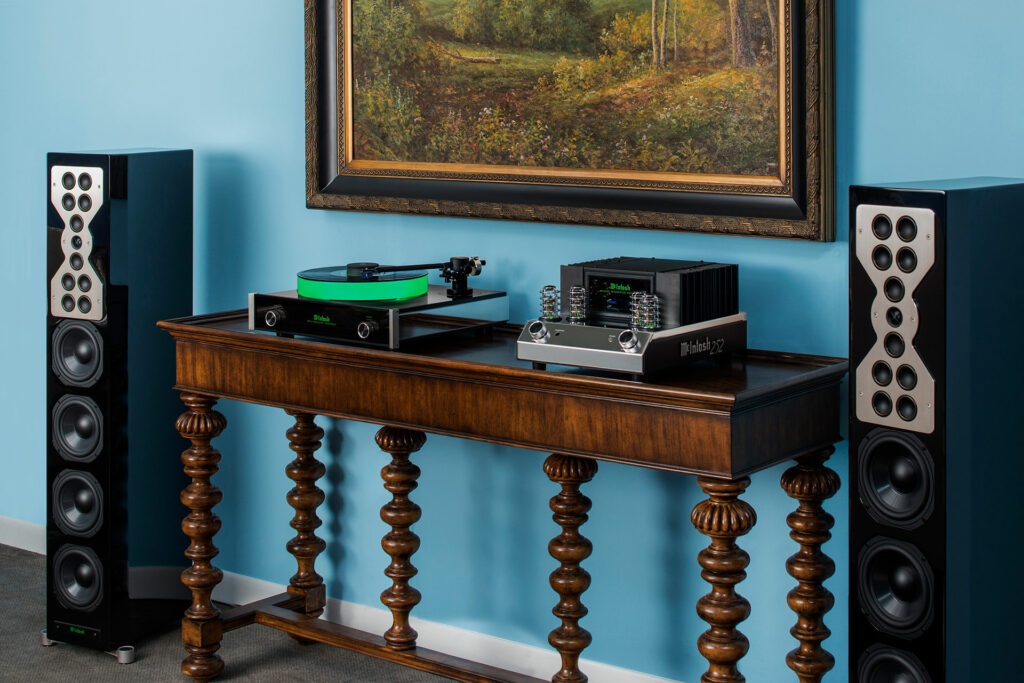
What Makes the McIntosh MT5 Turntable So Special?
- McIntosh very smartly packages this turntable in a highly polished glass and stainless-steel enclosure. The sides, front and top are all highly polished glass, consistent with most McIntosh products.
- The McIntosh name in the center of the front is illuminated in the now very familiar greenish-blue McIntosh lights. The acrylic platter is also illuminated, making this turntable fun to watch when being played. The lights are LED to ensure long life. The delivers an awful lot of cool factor.
- There is a magnetically suspended ceramic bearing, along with a cushion of air, which provides vibrational free platter operation. I found the platter to remain absolutely silent during operation.
- A Swiss-made DC motor coupled with a highly accurate servo system provides accurate rotation at all speeds. The turntable itself is belt-driven.
- There are three operational speeds available, 33.33 RPM, 45 RPM and 78 RPM. These are selected by a front-mounted round knob. A rear-mounted fine adjustment screw allows for precise calibration of the rotational speed. My platter app on my iPhone tracked the speed at 33.39 RPM. This is well within my margin of error, and required no manual adjustment.
- The tonearm is made from Dural-Aluminum, and is specially dampened to provide both rigidity and light weight.
- A dustcover is included, something not all turntable manufacturers provide.
- A host of setup tools are also thoughtfully included. These include a small screwdriver, several Allen wrenches, a bubble level, tracking force gauge, bearing oil (required for setup), a very easy to use overhang gauge (very helpful if using a different cartridge), a pair of white gloves to keep fingerprints at bay and a user guide, along with warranty information.
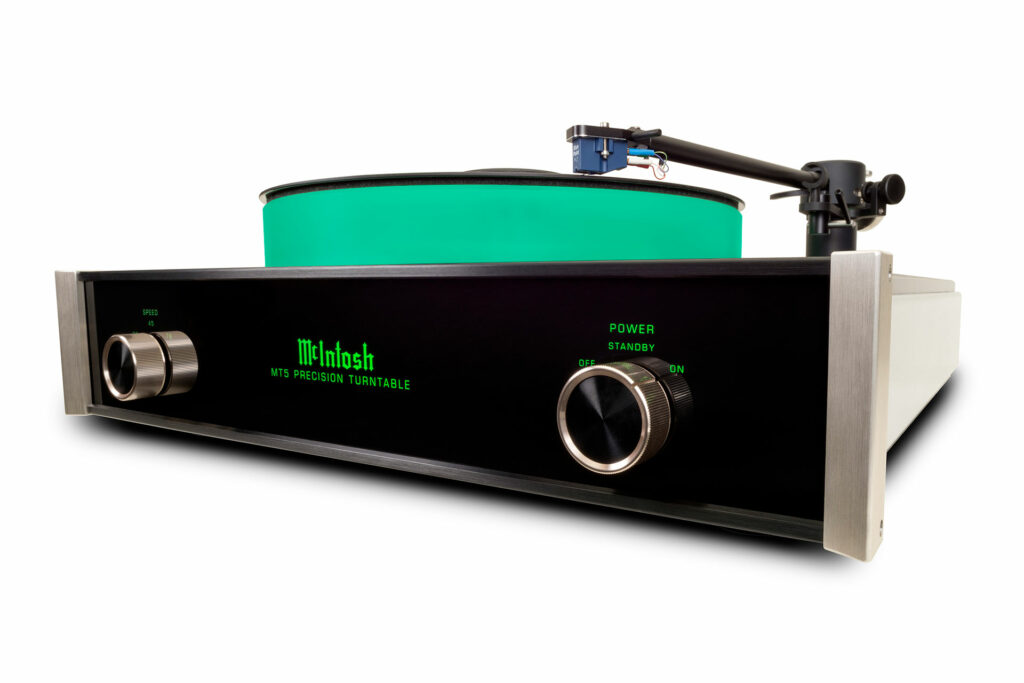
Why Should You Care About the McIntosh MT5 Turntable?
Across the width and breadth of the audiophile landscape, choices for turntables abound. With the rise in popularity of LPs, more and more practitioners of our little hobby are including analog in their audio systems. What the McIntosh MT5 offers is a product from a company with a 75-plus-year legacy of building audio gear. And let’s be honest, who among us does not like that famed greenish light adorning every product the company makes? Oh, and I almost forgot – the MT5 sounds really fantastic as well.
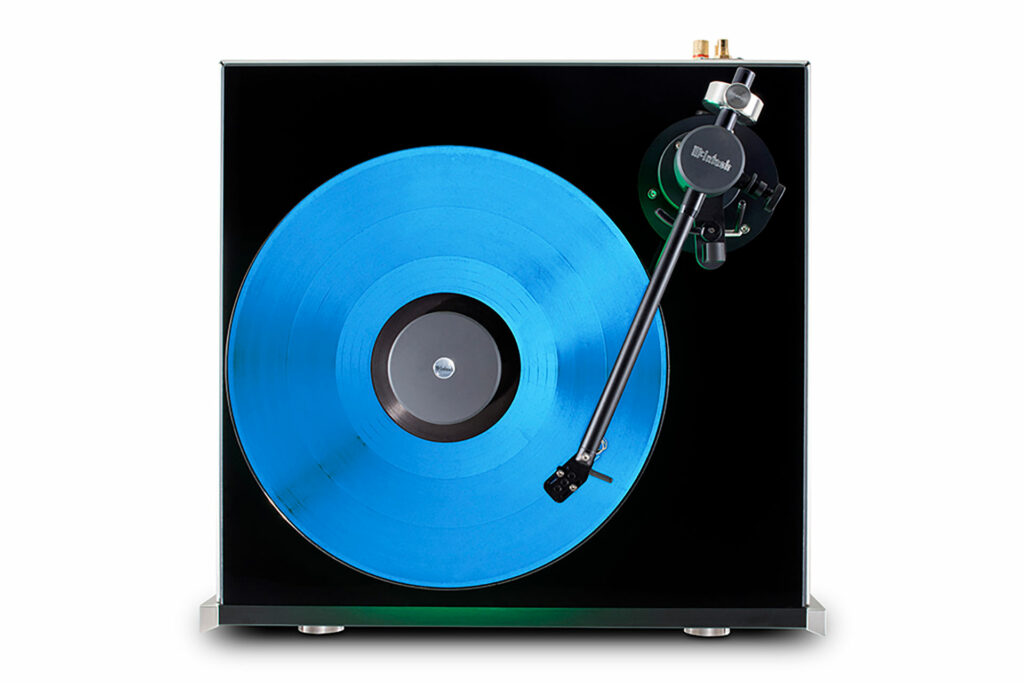
Some Things You May Not Like About the McIntosh MT5 Turntable …
- The McIntosh MT5 is prone to footfalls. I discovered this when the first album I played was near the end of side one and, as I approached the audio rack, I heard the telltale sound of a tonearm bouncing. This is partly due to the magnetically-suspended platter. My second-floor audio room doesn’t help, either. There is an easy fix for this, however – walk softly and turn down the volume before approaching the turntable.
- While the included Sumiko Amethyst cartridge is factory-mounted to the headshell, a rather significant amount of cartridge and tonearm setup is still required. McIntosh includes an easy-to-use protractor and various tools for tonearm setup. Even so, this is not a “plug and play” device. For anyone hesitant about tonearm and cartridge setup, this may be a task best accomplished by an authorized McIntosh dealer.
- The stylus force gauge McIntosh provides is not really a gauge I would trust or want to use. A digital version may be purchased for less than $10, so the accuracy and useability of the included version is questionable. I use an Ortofon DS-3 Stylus Force Gauge ($179.00), which provides a highly accurate setting. I would like to see McIntosh step up the game just slightly with a digital gauge, rather than what they supply.
- The right-hand, front-mounted round knob controls the power settings. There are three selections: power off, standby and power on. I was under the impression that the standby setting would continually illuminate the McIntosh name in the middle of both front-mounted knobs. I was looking forward to seeing the company name glowing in the darkened confines of my listening room. It would seem I am mistaken. In order to illuminate the name only, the turntable must be connected to a McIntosh preamp or integrated amp. Without a secondary McIntosh device, it is necessary to switch the power to the full on position, which lights up both the name and the platter. This is admittedly a minor thing, but I must confess that even reviewers like a little bling every so often.
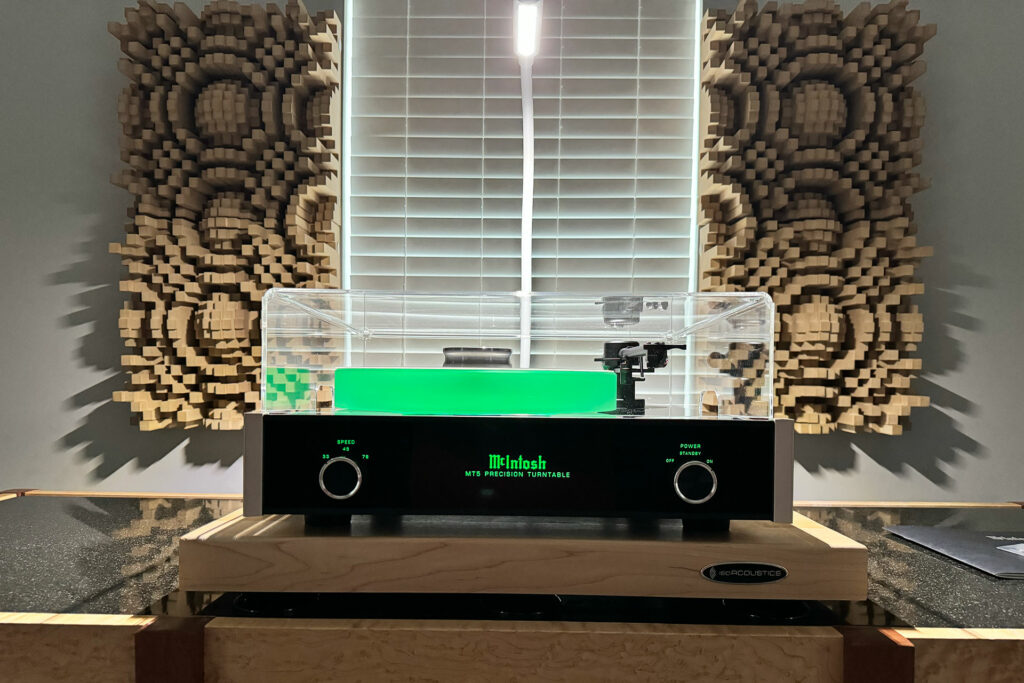
Setup, Connections and Modifications Used for This Review
- McIntosh supplies an AC/DC converter with a mini-jack connector, which plugs into the rear of the turntable. An audiophile-grade, 120v AC user-supplied power cord is not feasible, as it cannot be connected.
- As is my custom, I placed the McIntosh MT5 on an Iso Acoustics Delos platform. The feet on the MT5 are adjustable to ensure that the turntable is level.
- There is a certain amount of setup required to make this turntable ready for use. The platter and its various parts must be mounted, and the tonearm must be configured. Even with the cartridge factory-mounted in the headshell, overhang and horizontal alignment must be checked, and VTA, tracking force and anti-skating must also be calibrated. This took me between 30 minutes to one hour to complete.
- As is common with MM cartridges, I set the resistive load at 47k ohms, the capacitive load at 200pF (100pF is also sonically acceptable), and the gain at 66dB (53dB is typically recommended, but I decided against this setting, as I wanted better dynamics).
- My tonearm cable is a Nordost Valhalla II RCA/RCA phono cable.
- As I have with my last five or six turntables, I used a Stillpoints LPI center weight rather than the McIntosh-supplied version.
- After about a week of listening, I replaced the supplied platter mat with a rubber version I “borrowed” from my then-reference turntable – the Luxman PD-151 Mark II. This change lowered the congestion I was hearing with the McIntosh mat and really cleaned up the bass response. When I replaced my “borrowed” mat with a Herbies Way Excellent II, the sonics really took on a new life. Platter mats are a very personal thing but, in my case, the Herbies mat made a significant difference.
Listening with the McIntosh MT5 Turntable…
Despite my initial inclinations to replace the Sumiko Amethyst MM Cartridge with my reference Ortofon MC Verismo moving coil version, I decided against doing so. For one, I felt the review should be about the performance of the cartridge McIntosh supplies and not something else. Secondly, because the Verismo typically sells for anywhere between $7,000 and $7,500, and the Amethyst retails for $599, I did not feel this would really be a fair comparison. Something funny happened on the way to the party, however. After about two weeks of playing almost exclusively LPs, the Sumiko Amethyst MM cartridge began to grow on me. Suddenly, McIntosh’s decision to include this cartridge and not a different version was less puzzling than before.
What I really liked about this turntable and cartridge was the visceral sense of intensity. Instruments didn’t really go pop, they went POP! This may, of course, be attributable to a higher-than-suggested gain setting. Frequencies tended to meld together in a cohesive fashion – that is, bass did not overshadow the mids and highs, something I cannot stand. The transients were noticeable and well fleshed out, although not as demonstrable as I routinely hear on digital tracks. There was a power to the music more accurately resembling what I hear when playing the same tracks digitally through my music server and DAC. Clarity and accuracy were both acceptable, but could likely, almost certainly, be improved with a change to a superior cartridge. Image width and depth were also acceptable, but not as wide and deep as with my Luxman PD-151 Mark II turntable with the Ortofon MC Verismo cartridge. When comparing imaging on the MT5/Sumiko setup to digital, there is hardly a contest. Imaging in my digital section reigns supreme, and by a significant margin, on my audio system in my audio room.
In the remastered version of Jethro Tull’s Aqualung, the track “Wind Up” has always been one of my favorites. While lyrically a song regarding the rigors of institutionalized religion, educational mores and quite possibly Ian Anderson’s personal involvement with both, this track is, manifestly, a wonderful rock and roll song with something I always enjoy – high energy. What begins softly as a simple piano is soon replaced by an acoustic guitar. At the 1:36 mark, things become a little bolder, with the drums and guitar taking center stage. At the 2:06 mark, the frenetic energy which Jethro Tull can easily display is going full bore. With the McIntosh MT5 turntable, the bass was very tight, very lively and had an immediacy suggesting a live presentation. The guitar was amped up to provide sufficient feedback to make it sound like a rock song should sound. What impressed me most was how quiet the McIntosh MT5 was, from a very soft, relaxed beginning to the conversion to high octane just over two minutes in. On my system, this track sounded glorious.
One of my all-time favorites, the track “Running on Empty” from the album of the same name by Jackson Browne, is one of his most popular songs. On the album, some crowd noises may be heard just past the lead-in groove, and then, without warning, the drums and guitar more or less explode. The track then becomes more than a folk song, which is how Browne’s music is more typically remembered. With the McIntosh MT5, the drums had the same level of dynamic impact to which I have become accustomed on other tracks. The guitar, which in this song is very prominently featured, is equally dynamic as the drums. This is commonly referred to as dynamic linearity, or when the sonics from low frequencies to high have equal dynamic output. This track, played on the McIntosh MT5, reminded me why I have always enjoyed it as I have: it is still just a great rock and roll song, and one I really enjoyed hearing.
Does the McIntosh MT5 Turntable Have Any Resale Value?
Let’s be clear, with their legacy of building highly sought-after and respected audio products, all McIntosh components have a satisfactory resale value. Even products such as the MT5, is a turntable that may be passed on without too much issue. A resale value of 50 percent or more is not unreasonable. In checking the used gear sites, I found several with this turntable being offered for sale with $6,000 the highest price being asked. Given the $7,500 retail price for a new one, I doubt this one will sell for the asking price. It does show, however, how much of a market there is for used McIntosh products – even components like turntables, something for which the company is not primarily known.
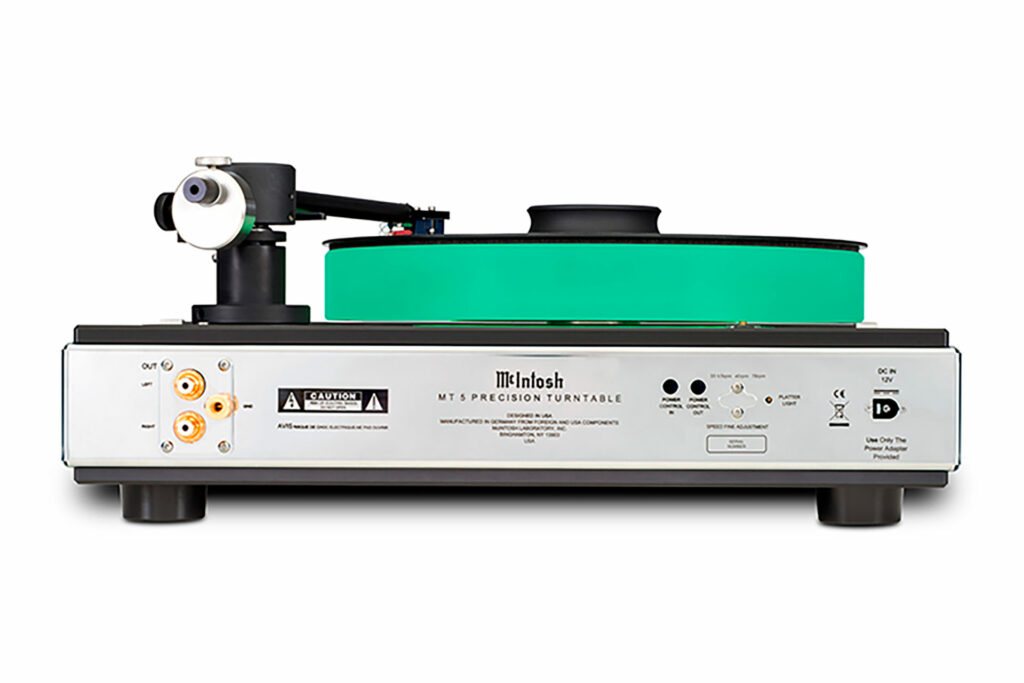
What is the Competition for the McIntosh MT5 Turntable?
First to mind is my current reference turntable, the Luxman PD-151 Mark II (read the review here).Now retailing at $6,500, it is slightly less than the McIntosh MT5. This price does not, however, include a factory-mounted cartridge or dust cover, as does the MT5. Add both of those to the Luxman, and the prices will be competitive with each other. Both turntables feature a high-precision DC motor, advanced servo systems, highly accurate speed control, both are belt-driven, and both feature outstanding sonics.
With over 50 years of continuous production, the Linn Sondek Majik retails for about $5,200. Depending on how it is configured, this turntable has versions with a retail price all the way up to $30,000. Linn uses and has always used a floating plinth, whereas McIntosh essentially uses a floating platter. Several options on the Majik include a MM or MC cartridge, both factory-mounted, and also an upgraded tonearm. These options on the Majik make it priced very competitively with the McIntosh MT5.
A very well-respected turntable, and one I used for several years, is the VPI Classic Signature (read review here). With a retail price of about $6,500, the Classic Signature is a standout turntable. There is no cartridge or dustcover included as standard. One feature I truly miss, and one VPI includes, is a user-adjustable round knob for on-the-fly VTA calibration. Thankfully, VPI has replaced the Unipivot tonearm, something frightfully difficult to really dial in, with a gimbaled version as standard. This change essentially reduces the need to do much in the way of azimuth calibration. The Classic Signature features a very quiet AC motor and a highly accurate platter speed.
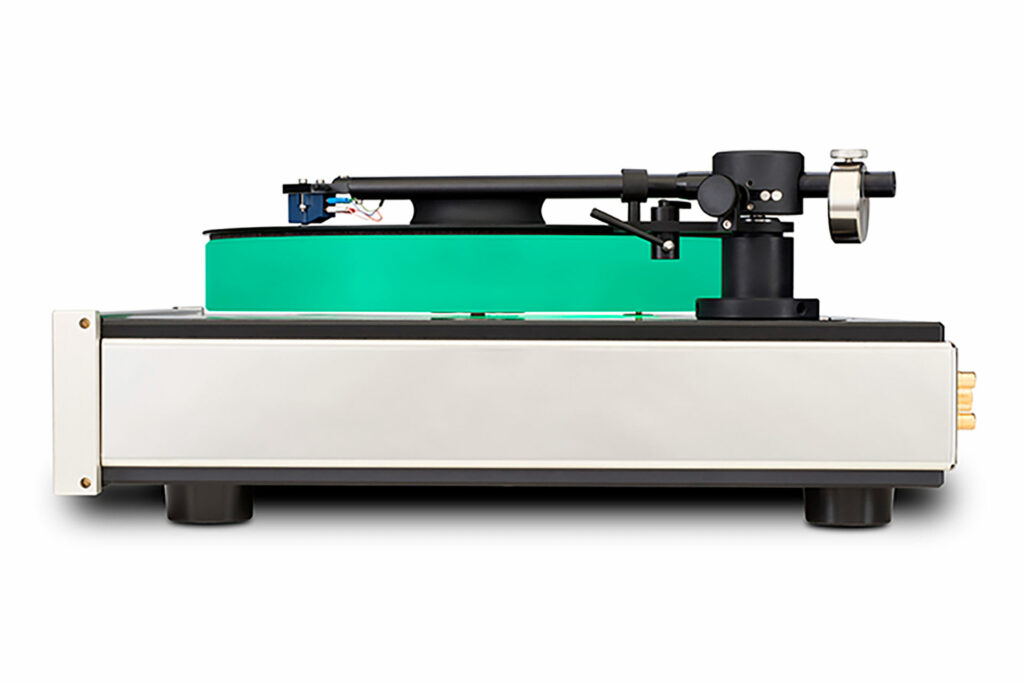
Final Thoughts on the McIntosh MT5 Precision Turntable
This turntable was fun to review and even watch. It demonstrated to me how much time I spend looking at the same ol’ rack of gear. Still, the sense of power this turntable supplies sonically, the overall musicality it portrays, and, well, the light show make the McIntosh MT5 Precision a very wise and enjoyable choice. Factor in an included cartridge, center weight, bubble level, stylus force gauge (which I still maintain could be much better) and the required tools to go from the box to playing music, and I feel the McIntosh MT5 is an outstanding choice for an analog section.
I found myself wanting to play another LP rather than my customary decision to switch back to digital. I cannot remember a turntable in my recent past for which I can make such a statement. The review forced me to clean and flip album after album and, surprisingly, this became a mostly ignored task. The preliminary process of LP maintenance and preparation took on a role of less aggravation and instead was simply a part of the analog process. The McIntosh MT5 is the first turntable in a long while to accomplish this feat in my listening room.
There are a plethora of turntables at vastly and wildly different price points from which an audiophile may choose. The same may be said for cartridges. What the McIntosh MT5 package provides is everything required, save of course for a phonostage and actual LPs, to open the box, set everything up and play music – and you get a really slick light show in the process. Not many choices in turntables today can legitimately offer all these options. I can unhesitatingly recommend the McIntosh MT5 Precision Turntable for anyone in search of a highly capable analog front end in the $7,500 or so price category.




Leading in with the legacy of McIntosh I feel in the purpose of transparency it should be mentioned the Mac turntables are built to McIntosh specifications by German company Clearaudio. This by no means takes anything away from the MT-5 as Clearaudio is a very well, respected analog brand and other companies like Mark Levinson and others prefer to contract out the building of turntables opposed to starting from the ground up. A common practice in hi fi and not only turntables.
It is rather garish as is most of Macs modern equipment. IMO. I’m surprised it doesn’t have meters. And controls on the front! What’s up with that?
Meters you say? You should check out the MT10.